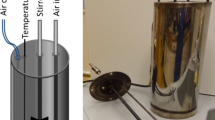Abstract
Bitumen is a product obtained from crude oil refinement. Its complex nature demands for a sophisticated approach to thoroughly assess it and link chemical composition, mechanical behavior and microstructure. Besides conventional mechanical testing, performance based test methods like dynamic shear rheometer (DSR) or bending beam rheometer (BBR) are gaining importance since they describe the actual viscoelastic behavior versus time and temperature. Furthermore, Fourier-Transformation-Infrared (FTIR) spectroscopy has recently become one of the most used analytical methods in bitumen research. The method give information regarding chemical composition in terms of functional groups and can distinguish between different ageing states and different kinds of modification. The presented study shows time and storage dependent effects on the surface and in the bulk of bitumen. It focuses on three main questions: (a) Is the surface and bulk affected by exposition to visible light within a timespan of up to 20 days? (b) Do the changes on the surface correlate with changes in bulk properties? (c) Does the surface of bitumen passivate, preventing further atmospheric oxidation? To answer these questions, two different unmodified binders were prepared and measured with FTIR and DSR. Half of the samples were exposed to visible light, while the others were stored in the dark at a controlled laboratory atmosphere. The results of FTIR spectroscopy show that the surface, when stored in visible light, passivates significantly with increasing storage time. When stored in the dark, no relevant changes are measured. The results from bulk (DSR) show the same trends but to a much lesser extent, compared to the surface. An overall sample storage in the dark is recommended. FTIR measurements should be conducted within an hour after preparation, while DSR measurements can be done up to one day after preparation.
Access this chapter
Tax calculation will be finalised at checkout
Purchases are for personal use only
Similar content being viewed by others
References
Hofko, B., et al.: Repeatability and sensitivity of FTIR ATR spectral analysis methods for bituminous binders. Mater. Struct. 50(3) (2017)
Hofko, B., et al.: FTIR spectral analysis of bituminous binders: reproducibility and impact of ageing temperature. Mater. Struct. 51(2), 45 (2018)
Handle, F., et al.: The bitumen microstructure: a fluorescent approach. Mater. Struct. 49(1–2), 167–180 (2016)
Petersen, J., et al.: Molecular interactions of asphalt. Tentative identification of 2-quinolones in asphalt and their interaction with carboxylic acids present. Anal. Chem. 43(11), 1491–1496 (1971)
Petersen, J.C., Glaser, R.: Asphalt oxidation mechanisms and the role of oxidation products on age hardening revisited. Road Mater. Pavement Des. 12(4), 795–819 (2011)
Chihara, G.: Medical and biochemical application of infrared spectroscopy. V. Infrared absorption spectra of organic sulfate esters. Chem. Pharm. Bull. 8(11), 988–994 (1960)
Larkin, P.: Infrared and Raman Spectroscopy. Principles and Spectral Interpretation, pp. 129–130. 225 Wyman Street, Waltham, MA 02451, USA: Elsevier (2011)
Acknowledgement
The authors would like to thank Solutions 4 Science Handels GmbH for providing the Perkin Elmer Spectrum TwoTM FTIR spectrometer and BMI Group S.à.r.l. for their financial support.
Author information
Authors and Affiliations
Corresponding author
Editor information
Editors and Affiliations
Rights and permissions
Copyright information
© 2022 The Author(s), under exclusive license to Springer Nature Switzerland AG
About this paper
Cite this paper
Mirwald, J., Werkovits, S., Camargo, I., Maschauer, D., Hofko, B., Grothe, H. (2022). Time and Storage Dependent Effects of Bitumen—Comparison of Surface and Bulk. In: Di Benedetto, H., Baaj, H., Chailleux, E., Tebaldi, G., Sauzéat, C., Mangiafico, S. (eds) Proceedings of the RILEM International Symposium on Bituminous Materials. ISBM 2020. RILEM Bookseries, vol 27. Springer, Cham. https://doi.org/10.1007/978-3-030-46455-4_235
Download citation
DOI: https://doi.org/10.1007/978-3-030-46455-4_235
Published:
Publisher Name: Springer, Cham
Print ISBN: 978-3-030-46454-7
Online ISBN: 978-3-030-46455-4
eBook Packages: EngineeringEngineering (R0)




